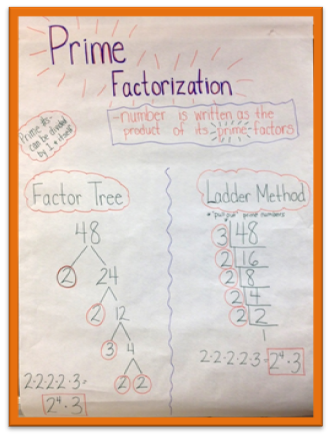This may sound odd, but I have come to REALLY love the way we can use prime factorizations in math class! When I told my son (he's 19) that I was going to write about prime factorization for this guest blog post, he gave me a look that seemed to say, “Seriously, that’s what you’re going to write about?” But this year especially, every day that we talk about using prime factorization, I just get so excited about it! Is it weird?? Maybe...but I wanted to share my excitement!
Every year, I find that I appreciate prime factorization more and more. Maybe it’s because when I was in school (quite a while ago!), I didn’t learn how to use prime factorization to find greatest common factors, least common multiples or to reduce fractions. (I will admit to the possibility that I learned and forgot….but I truly think I didn't learn it!). In addition to missing this information as a student, I didn't find it in teacher manuals until the past several years (I’ve been teaching for 22 years now). I hope I’m not alone in missing out on the uses of prime factorization in my education, but if I am, I hope you’ll still read about why am I am loving it so much!
GCF: I like using prime factorization to find greatest common factor because my students often miss factors of some numbers, and when they miss factors, they end up missing the GCF. Using prime factorization, they DON'T miss these factors and they are more successful in identifying the GCF.
To find GCF using prime factorization:
First, find the PF of each number.
Next, identify the factors that the numbers have in common (12, 24, and 32 each have two 2s).
Last, multiply those factors that are in common (2 x 2 = 4, so GCF is 4).
 Reducing: In years past, when students reduced fractions, they often chose ANY factor to divide by, (unless they were forced to find the GCF). Then, they would reduce and reduce again, and sometimes they still didn't reach lowest terms. For example, some students would take 54/72 and divide by 2 to get 27/36. Then they might divide by 3 to reach 9/12. Some might stop here and never reach lowest terms at all.
Reducing: In years past, when students reduced fractions, they often chose ANY factor to divide by, (unless they were forced to find the GCF). Then, they would reduce and reduce again, and sometimes they still didn't reach lowest terms. For example, some students would take 54/72 and divide by 2 to get 27/36. Then they might divide by 3 to reach 9/12. Some might stop here and never reach lowest terms at all. To reduce using PF:
First, find the prime factorization of each number.
Next, cross out the factors that are in common (54 and 72 have one 2 and two 3s in common, so they are crossed out)
The remaining factors are the numerator and denominator of the reduced fraction (if more than one factor remains in either the numerator or denominator, they should be multiplied).
LCM: Using prime factorization to find the least common multiple is fantastic! Listing multiples can be quite tedious (though it does reinforce multiplication facts), and although finding the PF might be difficult for students to begin with, it will eventually be quicker than listing multiples. I know that as I've been talking about PF so much this year, and thinking about it aloud so the students can hear my thought process in breaking down numbers, my students are finding prime factorizations much more quickly than students in the past.
To find LCM with prime factorization:
First, find the prime factorization of each number. Next, identify the different factors of each number. If a factor is found in both numbers, count it the greatest number of times it appears in either number. For example, in the prime factorizations of 8 and 30, 2 occurs three times in 8 and only once in 30, so it is multiplied three times to find the LCM.
Next, identify the different factors of each number. If a factor is found in both numbers, count it the greatest number of times it appears in either number. For example, in the prime factorizations of 8 and 30, 2 occurs three times in 8 and only once in 30, so it is multiplied three times to find the LCM.
When finding the LCM of 6, 7, and 14, we can see that the factors 2, 3, and 7 occur once at most, so they are each multiplied once to find the LCM of 42.
Some students are comfortable with ways they've learned in previous years and are hesitant to use PF; but I'm so excited that other students have actually come to me during our study period to double check how to use PF in these ways, because they LIKE it and think its cool!
 |
| Click here to download! |
Feel free to download and use it.
I hope you enjoy prime factorization! Are there any other ways you use prime factorization with your students?
Have a great week!

Middle School Math Moments Blog
Middle School Math Moments on Pinterest
Middle School Math Moments TPT Store
















0 comments:
Post a Comment